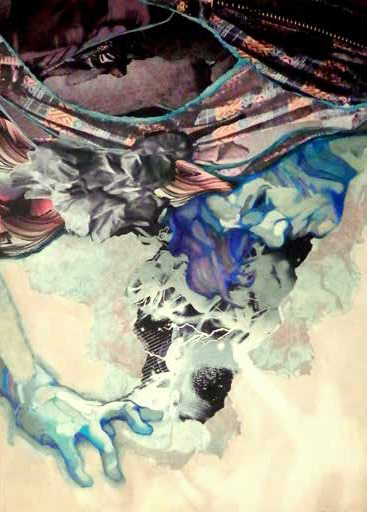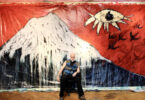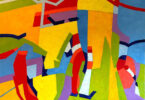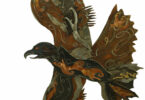“Although my paintings have literary sources, they are not illustrative,” says Bob Tomlinson, a Jamaican-American painter currently living in Paris whose new show, “Fragments of Myth,” will open March 15, 2016, at Viridian Artists in Chelsea.
Tomlinson’s vibrant paintings are combinations of oil, elaborately textured and printed papers as well as computer manipulated photographs. The papers, often a particular type of Japanese paper called “washi,” is made from bark fibers, which the artist collages on the canvas. “The art papers may have some texture, but I generally avoid anything too emphatic,” he says. The combination of textures produces pictorial depth, creating powerful and emotionally charged paintings. What Tomlinson enables us to see, aside from paintings animated by bold colors, are the abstract possibilities in partially figurative works.

oïl and collage on canvas
26″ x 18″ 2O15
What unites the paintings in this show is what Tomlinson calls “intentionally vague narratives.” His titles are important. In other words, Tomlinson lets his titles such as “Josephine Baker” and “The Expulsion from the Garden” or “Lament for Ignacio Sanchez Mejias” (a Spanish bullfighter memorialized in a poem by Frederico Garcia Lorca) be the springboard for an appreciation of his work. The courtesan heroine in Alexandre Dumas’ novel, “La dame aux camellias,” is the subject of both paintings of the heroine and several still lifes of camellias.
Various characters from the Bible, literature, past and contemporary culture are the inspiration for many of these paintings but as Tomlinson says: “They don’t represent any particular moment.” They are just starting points growing out of a series of artistic choices about form and line. Each are “actors who hover on the frontier between figuration and abstraction…both formally and philosophically, they can only reach us as fragments,” says Tomlinson.
What is most appealing about his paintings is that they are imbued with mystery. The artist does not seem interested in revealing character with facial expressions. For Tomlinson, the eyes do not reveal what the heart conceals. In his work rhythm and color lead the eye to discover a fragmented form which the artist uses to create what he calls “a tendency toward abstraction.” His colors are so vivid you can only imagine that his Paris studio is bathed in light.
In “Prince Genji,” a painting inspired by the 12th century Japanese classic novel, “The Tale of Prince Genji,” by Lady Murasaki, Tomlinson offers us a hero, a strongly outlined three-quarter figure, an image of strength, fragmentary but complete in itself. The intensely alive hero seems to be yearning for something beyond his reach. His face is titled upward, eyes tightly closed. The image is at once poetic and energetic. Perhaps we have caught the hero as he dreams. In this and other portraits in this show, the body is a form in space and the work is about color and line.
Even as a college student Tomlinson was fascinated with the Japanese classic, “The Tale of Prince Genji.” He recalls that he worked in the library at Pratt Institute. “Evenings when I was the only one on duty and it was quiet…I would rumble around in the dusty basement stacks where a copy of the original Arthur Waley translation was hidden away.” It is probably the first real novel in a modern sense and at the same time perfectly archaic. Even the Japanese don’t read it in the original… It also reminds me of Proust, a rumination of a fading Golden Age.”
Tomlinson’s painting, “The Dance of Salome,” like that of “Prince Genji,” has that same mystical and enigmatic quality. An admirer of Gustave Moreau (1826-1898), who painted many versions of Salome dancing, he captures the Judean princess dancing before her stepfather King Herod and her mother, Herodias. For the artist, the following excerpt from Gustave Moreau’s notebook is one source for Salome. He wrote: “This dance is performed, this mysterious promenade is realized in front of death who watches her incessantly, gaping and attentive…”
Both paintings, “The Dance of Salome” and “Prince Genji,” withhold their meaning. We see the Biblical figure not draped in seven veils nor presenting the head of John the Baptist on a plate to the king as she is usually portrayed. Instead, her eyes are tightly clenched, lips pursed, arms stretched out. Salome’s torso and the greenish background are painted. The rest is collaged. “The sensuous color and bold, sinuous contours, twisting back upon themselves lead us into realms of erotic and psychological complexity,” writes the artist in his gallery notes.
Tomlinson’s semi-abstract paintings with their dynamic brushwork and textures create powerful and emotionally charged scenes, both enigmatic and secretive. He succeeds marvelously in conjuring up images that challenge the eye as well as the mind. “At once lyrical, ironic and melancholic, these images, reminiscent of a Baroque/Rococo aesthetic, present surrealist juxtapositions of imagined spirits, shrouded in enveloping mystery and haunted by the memory of apocalyptic visions,” writes Tomlinson. What Georges Braque wrote about art applies to this artist’s complex and compelling paintings: “The only thing that matters in art is what cannot be explained.”
A graduate of Brooklyn’s Pratt Institute and the City University Graduate Center, Bob Tomlinson is also a scholar of French literature and aesthetics. His work has been shown extensively in Paris as well as London, Amsterdam, and New York and he is represented in several international museums and private collections. Bob Tomlinson is profiled in recent books: “100 New York Painters” by Cynthia Maris Dantzik and “Black Paris Profiles” by Monique E. Wells. He is also the subject of a work-in-progress film by prize-winning American documentary filmmaker Louis Massiah.
Viridian Artists, Inc. 548 West 28th Street, 212-414-4040
viridianartistsinc.com





You might know that Frank (1935- ?) from England now in Paris has been trying to get hold of Robert Tomlinson and It might be you have an Idea…if not where he is in paris…but which gallery shows him and through there….etc etc. I believe we are the same age and I missed him in the late 1960s when I lived in Paris in the next Building to Baldwin and Belvedere. Very Best Frank
Hello Frank,
We have forwarded your request to a US-Parisian art blog that collaborated with Robert and will let you know by email if we manage to gather information regarding the whereabouts the artist.
Best regards,
Gallery&Studio.